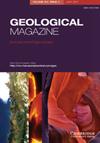尼泊尔中西部喜马拉雅中地壳剪切带演化的制约:喜马拉雅变质核构造演化的启示
IF 2
3区 地球科学
Q3 GEOSCIENCES, MULTIDISCIPLINARY
引用次数: 0
摘要
摘要通过构造分析、岩石年代学和变质岩石学,对尼泊尔中西部喜马拉雅变质岩心中一个新发现的高温韧性剪切带Jagat剪切带(JSZ)进行了识别和时序划分。原位U-Th-Pb单氮石岩石年代学限制了28-27 Ma和17 Ma之间的顶向南/西南剪切时间。下盘岩石的埋藏和进变质作用与沿JSZ方向的逆冲运动有关,而上盘岩石则是退变和出露的。JSZ的识别和年龄(作为剪切带区域系统的一部分:高喜马拉雅不连续带(HHD))与主中央逆冲(MCT)活动的定位和时间相结合(i)填补了沿造山带走向追踪高喜马拉雅不连续带的空白,(ii)支持对长期争论的MCT的位置和时间的识别,(iii)有助于确定喜马拉雅变质核及其内部结构的边界。因此,我们的研究为精确识别喜马拉雅变质岩心的埋藏、聚集和发掘机制迈出了重要的一步。本文章由计算机程序翻译,如有差异,请以英文原文为准。
Constraining the evolution of shear zones in the Himalayan mid crust in Central–Western Nepal: implications for the tectonic evolution of the Himalayan metamorphic core
Abstract Structural analysis, petrochronology and metamorphic petrology enable identification and bracketing of the timing of a newly mapped high-temperature ductile shear zone (Jagat Shear Zone (JSZ)) in the Himalayan metamorphic core in Central-Western Nepal. In situ U-Th-Pb monazite petrochronology constrains the timing of top-to-the-S/SW shearing between 28–27 Ma and 17 Ma. Burial and prograde metamorphisms in footwall rocks were linked to thrust-sense movement along the JSZ, while the hanging wall rocks were retrogressed and exhumed. The identification and age of the JSZ (as part of a regional system of shear zones: the High Himalayan Discontinuity (HHD)) coupled with the localization and timing of activity of the Main Central Thrust (MCT) (i) fills a gap in tracing the HHD along orogenic strike, (ii) supports the identification of the position and timing of the long-debated MCT and (iii) helps to place the boundaries of the Himalayan metamorphic core and its internal architecture. Thus, our study is a significant step towards a precise identification of the burial, assembly and exhumation mechanisms of the Himalayan metamorphic core.
求助全文
通过发布文献求助,成功后即可免费获取论文全文。
去求助
来源期刊

Geological Magazine
地学-地球科学综合
CiteScore
4.70
自引率
0.00%
发文量
111
审稿时长
3 months
期刊介绍:
Geological Magazine, established in 1864, is one of the oldest and best-known periodicals in earth sciences. It publishes original scientific papers covering the complete spectrum of geological topics, with high quality illustrations. Its worldwide circulation and high production values, combined with Rapid Communications and Book Review sections keep the journal at the forefront of the field.
This journal is included in the Cambridge Journals open access initiative, Cambridge Open Option.
 求助内容:
求助内容: 应助结果提醒方式:
应助结果提醒方式:


